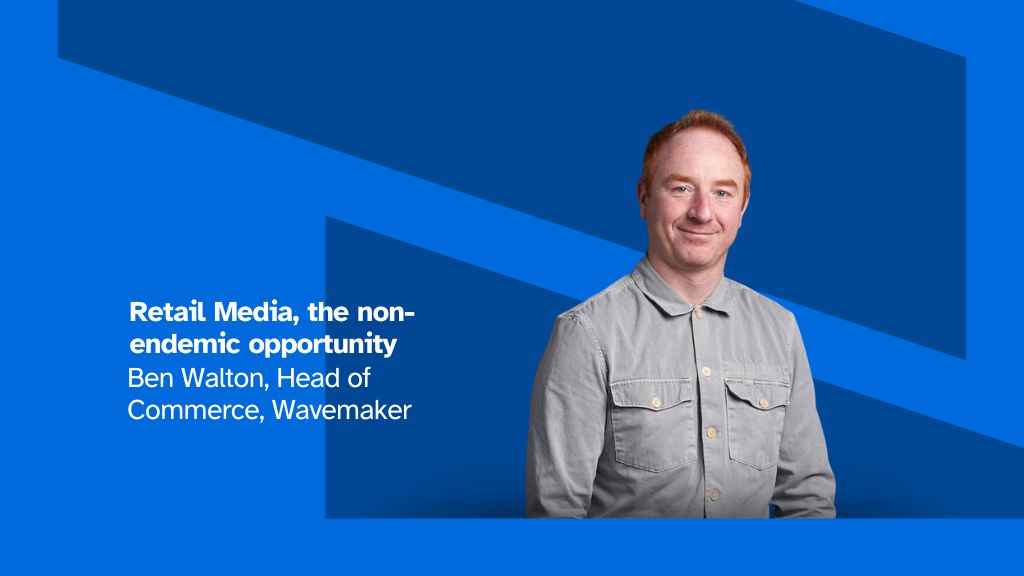By Ben Walton, Head of Commerce, Wavemaker
The industry is awash with the latest news, forecasts and opinions about retail media. The 3rd wave, £7.8 bn, bigger than connected television (CTV) – the updates are endless. Most of us who are close to retail media and commerce, know that retail media is the future for consumer packaged goods (CPG) brands.
But what about brands that don’t sell in Tesco, Boots or Amazon, which we, the industry, call non-endemics (non–endemic the industry term for brands that don’t sell through retailers)? How do they take advantage of this growing opportunity?
In a world where marketing effectiveness is a priority and with the cookie deprivation, the emphasis is on data quality, privacy and governance – all of which come at an expensive cost and significant risk for brands.
In the UK, retailers are now starting to talk about opening up their data for non- endemic brands. Amazon currently allows advertisers to utilise their demand-side platform (DSP) for brands that don’t sell on Amazon, giving them access to vast amounts of Amazon data.
In the US, Walmart is opening up Walmart Connect to brands that have not traditionally sold their products in its stores, such as automotive and financial.
Sainsbury’s and Tesco are in the process – the latter more recently opening it up for its Clubcard partners although data and inventory is limited – are all exploring the opportunity to offer this to brands. Ocado has already implemented this.
So, retail media networks (RMNs) will offer significant opportunities for non-endemic brands. Here is a look forward to what those benefits would be:
Access to First-Party Data: Retailers possess rich first-party data from their customers, including purchase history, browsing behaviour, and demographic information. Non-endemic brands can leverage this data to target audiences more effectively, utilising precise audience segments to target ads, ensuring messages reach relevant consumers.
Contextual Advertising: RMNs will allow non-endemic brands to place ads in a shopping or editorial context (through retailers’ publishing partners). This can bring a number of benefits for brands, including relevant ad placement. Where ads can be displayed alongside relevant product categories, enhancing the contextual relevance and effectiveness of them. Also, improved consumer engagement as shoppers are more likely to engage with ads that are contextually relevant to their current shopping and browsing activity. Finally, better conversion rates as ads shown to consumers who are ready to buy can yield higher conversion rates compared to other advertising channels.
Enhanced Personalisation: Create highly personalised and contextually relevant ad experiences based on consumer behaviour insights, overlaying shopping behaviour coupled with relevant moments and contextual synergies. By tailoring experiences to individual preferences, brands can create more enjoyable and relevant interactions for customers, leading to greater advertising effectiveness and improved loyalty.
Cross-Selling Opportunities: Non-endemic brands can benefit from cross-selling opportunities. Partnering with Endemic Brands, they can create joint campaigns with products sold by the retailer, which can drive mutual benefits for each brand. Collaborative promotions would be a great example of this. Joint campaigns can leverage the retailer’s brand credibility and customer trust to boost the effectiveness of advertising efforts.
Brand Safety and Control: Advertising within RMNs ensures a controlled environment, reducing the risk of brand safety issues. Non-endemic brands benefit from being in trusted environments: Ads are shown on reputable retail sites, enhancing brand safety and trust.
Competitive Advantage: Leveraging RMNs can provide non-endemic brands a competitive edge. Accessing specific growth audiences and reaching consumers who might not be accessible through traditional advertising channels and targeting them in the relevant channels with relevant messages.
Advanced Attribution and Measurement: While RMN’s offer closed loop measurement for endemic brands now, this will extend to non-endemics in the future. Amazon has developed its measurement solutions so that the impact of media on and off Amazon can be tracked to in store through a sales uplift or to an action to a site. You also have the ability to use Amazon marketing cloud, to optimise media for non-endemics. Retailers like Tesco will follow suit, offering non endemic brands the ability to track the impact of their media, utilising detailed performance data to refine targeting and creative strategies for better results.
To maximise the opportunities in retail media, non-endemic brands should consider the following:
- Data Collaboration: Work closely with retail partners to gain insights and optimise targeting.
- Creative Optimisation: Develop ad creatives that are tailored to the shopping context and consumer journey.
- Omnichannel Integration: Integrate retail media efforts with other marketing channels for a cohesive strategy.
- Continuous Monitoring: Work with the retailers to implement robust measurement solutions, such as MMM or sales uplift studies.
So come on non-endemics, get on board the retail media express train!









